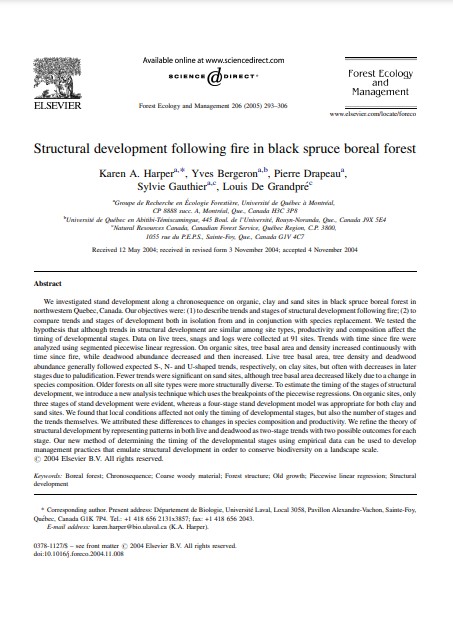Structural development following fire in black spruce boreal forest
Bosque Modelo:
Lake Abitibi
Temática:
Gestión forestal
Tipo de documento:
Artículo científico
Resumen
We investigated stand development along a chronosequence on organic, clay and sand sites in black spruce boreal forest in northwestern Quebec, Canada. Our objectives were: (1) to describe trends and stages of structural development following fire; (2) to compare trends and stages of development both in isolation from and in conjunction with species replacement. We tested the hypothesis that although trends in structural development are similar among site types, productivity and composition affect the timing of developmental stages. Data on live trees, snags and logs were collected at 91 sites. Trends with time since fire were analyzed using segmented piecewise linear regression. On organic sites, tree basal area and density increased continuously with time since fire, while deadwood abundance decreased and then increased. Live tree basal area, tree density and deadwood abundance generally followed expected S-, N- and U-shaped trends, respectively, on clay sites, but often with decreases in later stages due to paludification. Fewer trends were significant on sand sites, although tree basal area decreased likely due to a change in species composition. Older forests on all site types were more structurally diverse. To estimate the timing of the stages of structural development, we introduce a new analysis technique which uses the breakpoints of the piecewise regressions. On organic sites, only three stages of stand development were evident, whereas a four-stage stand development model was appropriate for both clay and sand sites. We found that local conditions affected not only the timing of developmental stages, but also the number of stages and the trends themselves. We attributed these differences to changes in species composition and productivity. We refine the theory of structural development by representing patterns in both live and deadwood as two-stage trends with two possible outcomes for each stage. Our new method of determining the timing of the developmental stages using empirical data can be used to develop management practices that emulate structural development in order to conserve biodiversity on a landscape scale.
Información Bibliográfica
Autor:
Harper KA, Y Bergeron, P Drapeau, S Gauthier and L De Grandpre.
Revista:
Forest Ecology and Management
Año:
2005
N°:
-
País :
Canadá
Páginas:
293 - 306
Volumen:
206
Idioma:
Ingles
Palabras claves
Chronosequence; Coarse woody material; Forest structure; Old growth; Piecewise linear regression; Structural development





